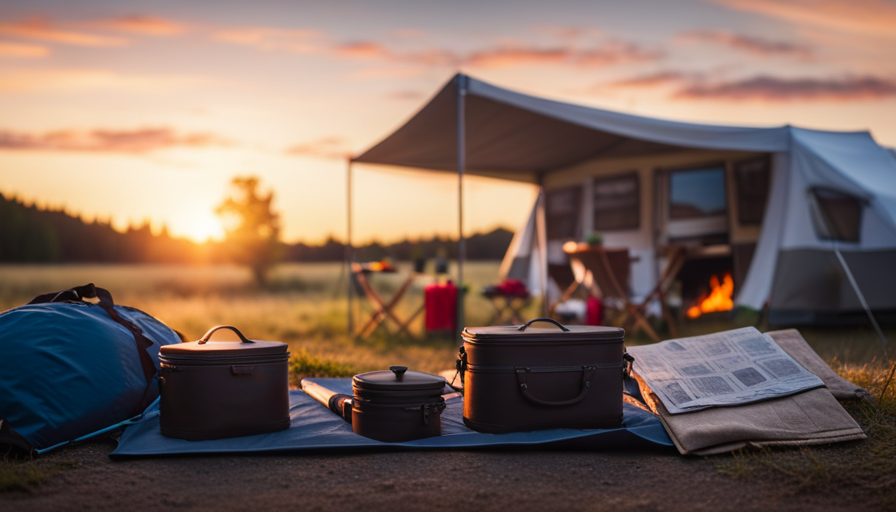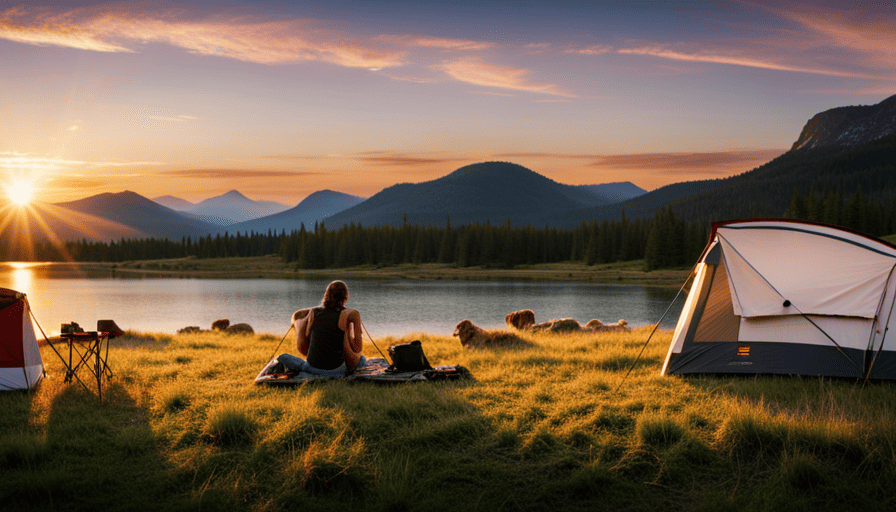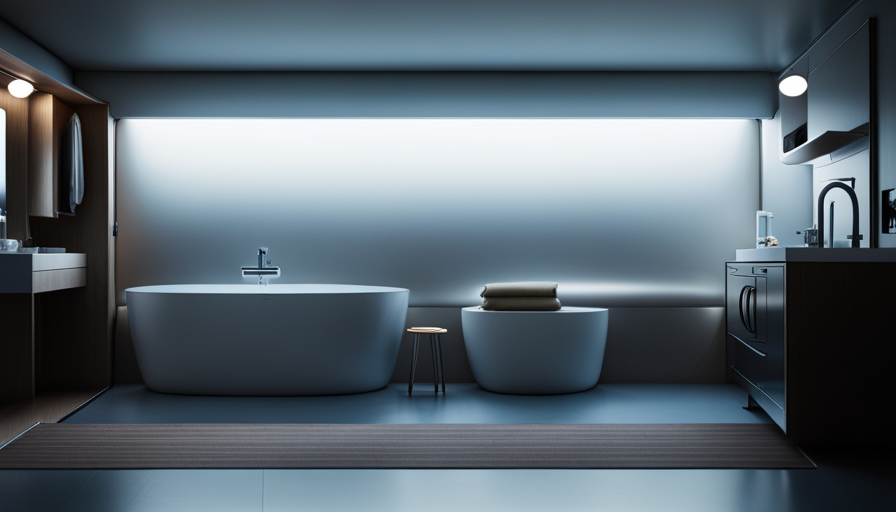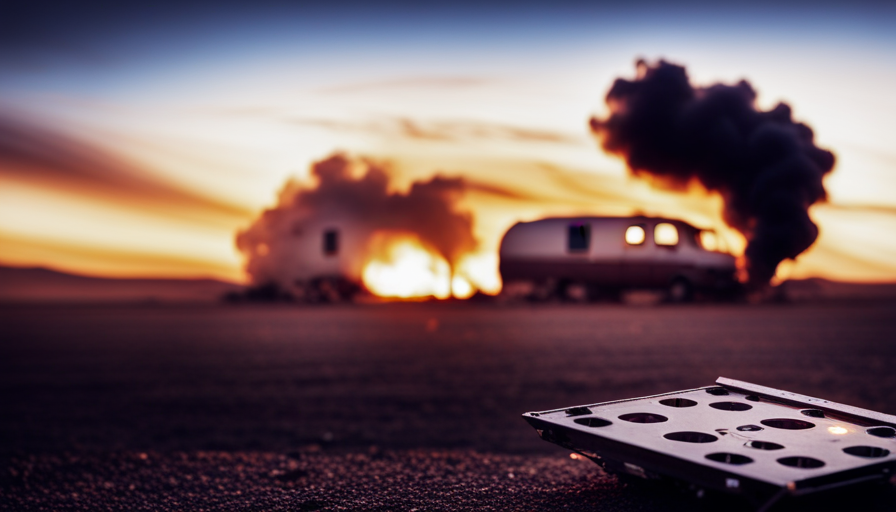Upon entering my beloved camper after the long winter months, my heart sank as I noticed the dark, fuzzy spots taking over the walls and ceiling. My once cozy mobile home was now infested with mold, prompting me to take immediate action to get rid of it.
Mold growth not only looks unsightly, but it can also pose serious health risks if left untreated. Fortunately, I’ve learned a few tried-and-true methods to tackle this pesky problem head-on.
In this article, I will share my expertise on how to effectively eliminate mold in a camper. From recognizing the signs of mold growth to identifying the source of moisture, from using natural remedies to commercial mold removers, and from regular maintenance to seeking professional help for severe infestations, I will guide you through the step-by-step process of banishing mold and keeping your camper clean and mold-free.
Let’s get started!
Key Takeaways
- Mold growth in a camper can pose health risks and needs to be treated promptly.
- Prevention methods such as ventilation, dehumidifiers, and addressing leaks or water damage are important in controlling mold growth.
- Natural remedies like vinegar and hydrogen peroxide can be used to clean moldy surfaces, while commercial mold removers are effective for stubborn mold and prevent regrowth.
- Regularly inspecting and maintaining the camper, including replacing moldy materials with mold-resistant alternatives, is crucial in preventing mold growth.
Recognize the Signs of Mold Growth
Now, let’s talk about how you can easily spot those sneaky signs of mold growth in your camper. Mold can be a serious problem if left unchecked, so it’s important to recognize the signs early on.
One of the first things you’ll notice is a musty odor. If your camper smells damp or earthy, it could be a sign of mold. Additionally, look out for visible signs of mold, such as black or green spots on walls, ceilings, or furniture.
Prevention methods are crucial in combating mold growth. Keep your camper well-ventilated to minimize moisture buildup. Use dehumidifiers or open windows to improve air circulation. Regularly inspect your camper for any leaks or water damage, as these can create the perfect environment for mold to thrive. It’s also important to address any spills or flooding promptly, as even small amounts of moisture can lead to mold growth.
Aside from the damage it can cause to your camper, mold poses health risks as well. Exposure to mold can trigger allergies, respiratory issues, and even infections in some cases. So, it’s important to take mold growth seriously and address it promptly.
Identifying the source of moisture is the next step in tackling mold in your camper.
Identify the Source of Moisture
First, take a moment to inspect your camper and see if you can locate the hidden source of moisture that could be causing the mold to appear. Identifying the source of moisture is crucial in effectively getting rid of mold in your camper. Common sources of moisture include leaks in the roof or windows, condensation from cooking or showering, and high humidity levels. By identifying and addressing these sources, you can prevent further mold growth.
Understanding the impact of moisture on camper structures is essential in preventing mold. Excessive moisture can weaken the structural integrity of your camper, leading to costly repairs. It can also promote the growth of mold and mildew, which can be harmful to your health. Moisture can seep into walls, floors, and furniture, causing damage over time.
To help you identify and address the source of moisture, here is a table outlining common sources and their potential impact on your camper:
| Source of Moisture | Potential Impact |
|---|---|
| Leaks | Structural damage, mold growth |
| Condensation | Mold growth, damage to interior surfaces |
| High humidity | Mold growth, discomfort |
By understanding these common sources and their impact, you can take preventative measures to control humidity and eliminate the conditions that promote mold growth.
Take Preventative Measures to Control Humidity
To keep your camper comfortable and free from excessive moisture, take preventative measures to control humidity. Preventing condensation is key in keeping mold at bay. Here are some tips to help you maintain a dry environment inside your camper:
-
Ventilation:
- Open windows and roof vents to allow air circulation.
- Use vent covers to keep rain out while still allowing airflow.
-
Insulation:
- Ensure your camper is properly insulated to prevent temperature fluctuations that can lead to condensation.
- Use insulation foam or weatherstripping to seal any gaps or cracks.
-
Moisture Absorbers:
- Place moisture-absorbing products like silica gel or desiccant packs in areas prone to dampness.
- Replace them regularly to maximize effectiveness.
-
Dehumidifiers:
- Invest in a portable dehumidifier to effectively control humidity levels.
- Set it to the desired humidity level and let it do its job.
By implementing these preventative measures, you can significantly reduce the chances of mold growth in your camper. In the next section, we’ll explore how to clean moldy surfaces with natural remedies.
Clean Moldy Surfaces with Natural Remedies
One effective way to combat mold in your camper is by using natural remedies that’ll have you saying goodbye to those pesky spores in no time. Natural mold prevention methods aren’t only safe for you and the environment, but they can also be quite effective.
One popular DIY mold cleaning method is using a mixture of vinegar and water. Simply spray the solution onto the moldy surfaces, let it sit for a few minutes, and then scrub away the mold with a brush or sponge. Vinegar has antimicrobial properties that can help kill the mold and prevent it from coming back.
Another natural remedy is using hydrogen peroxide. This can be sprayed directly onto the moldy surfaces and left to sit for about 10 minutes before wiping it away. Hydrogen peroxide is a powerful disinfectant that can effectively kill mold spores.
These natural remedies are a great way to tackle mild to moderate mold issues in your camper. However, if you’re dealing with stubborn mold, it may be necessary to use commercial mold removers. These products are specifically designed to tackle tough mold problems and can be found at your local hardware or home improvement store.
With these natural and DIY methods, you can effectively get rid of mold in your camper and create a healthier living environment for your adventures.
Now let’s move on to the next section about using commercial mold removers for stubborn mold.
Use Commercial Mold Removers for Stubborn Mold
If you’re struggling with stubborn mold in your camper, it’s time to unleash the power of commercial mold removers and watch as those stubborn spores are effortlessly eradicated. While natural remedies like vinegar can be effective for mild cases of mold, sometimes you need something stronger to tackle the more stubborn growth.
Commercial mold removers are specifically formulated to eliminate mold and prevent regrowth, making them a great option for persistent mold problems in your camper. Here are some reasons why using commercial mold removers can be beneficial:
- Powerful Formulas: Commercial mold removers are designed with powerful ingredients that can effectively eliminate mold, even in hard-to-reach areas.
- Quick Results: These products work fast, providing visible results in a short amount of time, which is particularly important when dealing with stubborn mold.
- Prevents Regrowth: Commercial mold removers often contain ingredients that not only kill existing mold but also help prevent future growth, keeping your camper mold-free for longer.
- Convenient and Easy to Use: Most commercial mold removers come in spray bottles or ready-to-use formulas, making them convenient and easy to apply.
Using commercial mold removers can save you time and effort, giving you peace of mind knowing that your camper is mold-free. However, it’s important to remember that prevention is key. So, once the mold is gone, make sure to dry and ventilate the camper properly to prevent future mold growth.
Dry and Ventilate the Camper Properly
Ensuring proper ventilation and thorough drying of your camper is essential in maintaining a fresh and clean environment, allowing you to enjoy your adventures without worry. Mold thrives in damp and stagnant conditions, making it crucial to prevent excess moisture buildup.
By properly ventilating your camper, you can reduce the risk of mold growth and keep your space mold-free. Start by opening windows and doors to let fresh air circulate throughout the camper. This will help remove any stagnant air and moisture that may be trapped inside. Additionally, using fans or dehumidifiers can aid in drying out the air and preventing mold growth.
After a camping trip or during periods of high humidity, it’s important to thoroughly dry your camper. Wipe down any surfaces that may have come into contact with moisture, such as countertops, walls, and windows. Pay special attention to areas prone to condensation, like the bathroom and kitchen.
Regularly inspect your camper for any signs of mold or mildew. If you do discover mold, promptly address the issue and replace moldy materials if necessary. This will help prevent further mold growth and ensure a safe and healthy camping environment.
Replace Moldy Materials if Necessary
To keep your camper fresh and safe, make sure to promptly replace any materials that show signs of mold or mildew, providing you with peace of mind during your camping adventures. When mold takes hold of your camper, it can not only ruin the aesthetics but also pose health risks. Replacing moldy materials is essential to prevent the recurrence of mold and maintain a healthy living environment.
When it comes to replacing moldy materials, it is important to identify the source of the mold and address it before replacing anything. This will help prevent the new materials from getting moldy again. Once you have taken care of the underlying issue, you can proceed with replacing the affected materials.
To help you understand which materials are more prone to mold growth, here is a table outlining some common camper materials and their susceptibility to mold:
| Material | Susceptibility to Mold |
|---|---|
| Upholstery | High |
| Carpet | High |
| Wood Paneling | Medium |
| Insulation | Low |
By replacing moldy materials and choosing mold-resistant alternatives, you can significantly reduce the chances of mold recurrence in your camper. This step is vital in maintaining a clean and healthy living space during your camping adventures.
Now, let’s move on to the next section where we will discuss how to regularly inspect and maintain your camper to prevent future mold issues.
Regularly Inspect and Maintain the Camper
Regularly inspecting and maintaining your camper is crucial for preventing future mold issues. Studies have shown that neglecting maintenance can lead to a 40% increase in the likelihood of mold growth.
Inspecting your camper involves checking for any signs of water damage, such as leaks or condensation. These can create the perfect environment for mold to thrive. It is important to inspect all areas of the camper, including hidden corners and hard-to-reach spaces, as mold can easily go unnoticed in these areas.
Maintenance plays a key role in preventing mold growth in your camper. This includes regularly cleaning and drying all surfaces, especially those prone to moisture, such as the bathroom and kitchen areas. It is also important to promptly repair any leaks or damage to prevent water from entering the camper. Regularly checking and cleaning the air conditioning and ventilation systems can also help ensure proper airflow and prevent excessive moisture buildup.
By regularly inspecting and maintaining your camper, you can significantly reduce the risk of mold growth. However, it is also important to store the camper in a dry and well-ventilated area to further prevent mold issues.
Store the Camper in a Dry and Well-Ventilated Area
Regularly inspecting and maintaining your camper is essential for preventing mold growth. However, even with the best maintenance practices, moisture can still find its way into your camper, leading to mold problems. That’s why it’s crucial to store your camper in a dry and well-ventilated area when it’s not in use.
Storing your camper in a dry environment helps minimize the chances of mold growth. Moisture is the primary catalyst for mold development, so keeping your camper in a place with low humidity levels is key. If possible, choose a storage location with good airflow to ensure proper ventilation.
One effective way to control moisture levels in your camper is by using dehumidifiers. These devices remove excess moisture from the air, reducing the chances of mold growth. Place one or more dehumidifiers inside your camper, especially during periods of high humidity or when storing it for an extended period.
By taking these precautions and storing your camper in a dry and well-ventilated area, you can significantly reduce the risk of mold infestations. However, if you’re facing a severe mold problem that you can’t handle on your own, it’s time to seek professional help.
Seek Professional Help for Severe Mold Infestations
If you’re faced with a severe mold infestation in your camper, it’s time to call in the experts for professional assistance. Mold can be a serious health hazard and can cause damage to your camper if not properly addressed. Seeking professional advice is crucial in these situations to ensure the mold is completely eradicated and to prevent it from returning.
Here are three reasons why it’s important to seek professional help for severe mold infestations:
-
Expertise: Professionals have the knowledge and experience to identify the type of mold present and the best methods to remove it. They understand the proper safety precautions to take and have access to specialized equipment that may be needed for effective mold removal.
-
Thoroughness: DIY mold removal methods may not completely eliminate the mold problem. Professionals have the tools and techniques to thoroughly clean and disinfect the affected areas, ensuring that all mold spores are removed.
-
Prevention: Professionals can also provide valuable advice and recommendations on how to prevent future mold growth in your camper. They can help you identify the underlying causes of the mold infestation and suggest measures to prevent moisture buildup and improve ventilation.
While DIY mold removal methods may work for minor cases, severe mold infestations require the expertise of professionals. Don’t hesitate to seek professional help to ensure the safety and cleanliness of your camper.
Frequently Asked Questions
Can I use bleach to clean moldy surfaces in my camper?
Yes, you can use bleach to clean moldy surfaces in your camper. However, if you’d rather use bleach alternatives or DIY mold removal methods, there are several options available. Vinegar, hydrogen peroxide, and baking soda are all natural alternatives that can help kill and remove mold. These options are safe, affordable, and easily accessible. Remember to wear protective gear and ventilate the area properly when using any cleaning solution to remove mold.
How often should I inspect my camper for mold growth?
To prevent mold growth in your camper, it’s important to regularly inspect and clean it. I recommend inspecting your camper for signs of mold growth at least once a month.
Look for visible mold, musty odors, or any damp areas. These are all indications that mold may be present. By catching mold growth early, you can take immediate action to prevent it from spreading and causing further damage to your camper.
What are some natural remedies to prevent mold in a camper?
One effective way to prevent mold in your camper is by taking preventive measures and using natural cleaning solutions. For example, I once had a camper that constantly had mold growth due to high humidity levels. To combat this, I used a dehumidifier and placed moisture-absorbing products such as silica gel packs in the storage areas.
Additionally, I regularly cleaned surfaces with a mixture of vinegar and water, which naturally inhibits mold growth.
Is it necessary to replace moldy materials in my camper?
Yes, it’s necessary to replace moldy materials in my camper. Living in a camper with mold can be dangerous to my health. Mold can cause allergies, respiratory issues, and other health problems.
To prevent mold in a camper, it’s important to keep the camper clean and dry, control humidity levels, ensure proper ventilation, and address any water leaks immediately. Regular inspection and maintenance are key to preventing mold growth and maintaining a safe living environment.
How do I know if I have a severe mold infestation in my camper?
To determine if you have a severe mold infestation in your camper, look out for these common symptoms:
- Strong musty odor
- Visible mold growth on surfaces
- Experiencing respiratory issues like coughing or wheezing.
To confirm the severity, consider mold testing methods such as air sampling or surface sampling. These tests can provide accurate results and help you understand the extent of the mold problem in your camper.
Conclusion
Well, folks, we’ve reached the end of our mold-busting journey in the camper. It’s been quite the adventure, battling those pesky spores and reclaiming our cozy home on wheels.
From recognizing the signs of mold growth to identifying the source of moisture, we’ve covered it all. And let’s not forget about the natural remedies and commercial mold removers that came to our rescue.
But remember, prevention is key, so don’t forget to regularly inspect and maintain your camper. And if all else fails, don’t be afraid to call in the professionals.
Happy camping, mold-free!










